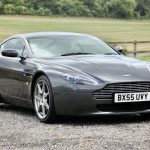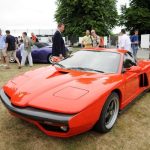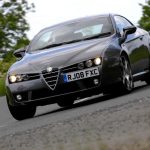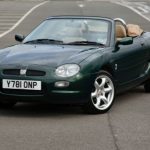Just over fifty years ago (17th January 1968 to be precise) one of the most famous (make that infamous) conglomerations in motoring history was established, with the founding of the British Leyland Motor Corporation Ltd (BLMC).
In a complex history with more twists and turns than the Nürburgring and a bigger cast than Ben-Hur, BLMC grew out of the merger of British Motor Holdings (BMH; made up of the former Nuffield/BMC marques, plus Jaguar/Daimler) and Leyland Motors (Rover, Leyland trucks, plus Standard-Triumph), which combined, accounted for more than 40 percent of the UK new passenger car market half a century ago.

The previous British Motor Corporation (BMC) group had including popular British vehicle makes such as Austin, Morris, MG, Riley and Wolseley, which produced such innovative models as the Mini, 1100/1300 and 1800, as well as the outmoded Morris Minor, Austin Cambridge and the sporty Austin-Healey 3000, amongst others.
BLMC’s Labour Government-appointed head, Leyland chairman Donald Stokes, sweetened with a Baronetcy, was given the unenviable task of simplifying the bewildering array of models produced by the new group. This included a dozen or more passenger car marques, in addition to commercial vehicles, tractors, and even white goods and tank transporters! He also had to resolve the internal disputes between previously competing manufacturers – Triumph insisting on developing its own V8 engine for its new Stag, for example, rather than adopting the existing, proven V8 motor from former rival Rover – plus poor profit margins, growing unrest with the production line workers and unions, and declining build quality standards.
The first all-new model launched by BLMC – the Austin Maxi – summed-up the many tough challenges Lord Stokes faced. The under-developed Maxi was rushed out too quickly into a marginal sales volume market sector, with a troublesome five-speed transmission, dreary interior and dumpy styling, compromised by the need to use the passenger doors of the larger Austin/Morris 1800 ‘Landcrab’ to reduce costs. The Maxi had to be rapidly re-worked and re-launched less than 18-months later to address the car’s initial problems.
Following the popular (if unprofitable) Minis and 1100/1300s of the 1960s, BLMC’s onslaught of post-Maxi ‘almost-but-not-quite’ new models continued into the early 1970s, with much-derided cars such as the Morris Marina, Austin Allegro and wedge-shaped Princess 18-22.
Higher up the price range, BLMC’s more prestigious brands included some potential 1970s world-beaters, including the Jaguar XJ6, Range Rover, Triumph Dolomite Sprint and Rover SD1. However, questionable build quality, poor management and constant BLMC factory trade union disputes and strikes hindered the true potential for these executive models.
Just seven years after its foundation, the cumbersome BLMC group was bankrupt, becoming partially nationalised in 1975, with the UK Government creating a new holding company known as British Leyland, which was later shortened to BL in 1978, commonly known as Leyland Cars.
By the time the long-anticipated Austin (Mini) Metro was released in late 1980, BLMC’s reputation in the UK (and overseas) had suffered irretrievable damage from which it never fully recovered. However, improving quality and trade union relationships, along with a contagious dose of British pride, saw the new Metro enjoy sales success, with the Honda Ballade-based 1981 Triumph Acclaim adopting Japanese-style production methods to also help restore faith in the Group’s products. Around the same time, BL’s now-classic MG and Triumph sports cars ceased production, with fashionable new ‘hot hatch’ models like the MG Metro and Maestro filling the demand for sportier performance models.
By 1982 memories of the troubled BLMC/BL era were thankfully beginning to fade, with BL Cars renamed Austin Rover Group (ARG) in anticipation of the important new mid-sized Maestro, Montego and Rover 200 model launches, with the prestigious Jaguar division being separated, and ultimately privatised, by 1984.
In 1986 the former-BLMC was rebranded again, to become the Rover Group, to further distance itself from its darker 1970s days, only to later become the MG Rover Group. A frustratingly short spell of credible models (Rover 200/25, MG F/TF, Land Rover Freelander, Rover 75/MG ZT, etc.) saw deserved reputation and sales growth, often helped by Honda-derived cars and planning, plus a brief period of ownership by BMW.
The successful Bavarian marque soon tired of MG Rover’s tittering business though, famously referring to the Group as ‘The English Patient’ and withdrew. It retained the rights to the Mini brand (along with dormant Triumph and Riley), and soon sold Land Rover off to Ford, before it was shifted again on to Tata, along with Jaguar.
Briefly returned to private British ownership post-BMW under the controversial Phoenix management team, the MG Rover Group finally went into administration in 2005, thus closing a major chapter in British motoring history from the UK’s once-dominant automotive group, with roots stretching back to the late 19th century.
The familiar Leyland ‘roundel’ logo still exists today in Turkey on a range of Ashok Leyland trucks, and the rights to the MG brand are now owned by the large Chinese SAIC vehicle group, with a return to the British market with a small range of UK-developed (but Chinese-built) hatchback and SUV crossover models. Who could have imagined this 50 years ago? Oh, how the mighty have fallen…!
Each year, Hagerty’s Festival of the Unexceptional celebrates the marques and models of the BL era with a family-friendly day out and good natured concours. For more information visit our Festival of the Unexceptional page.







The last paragraph is incorrect – Ashok-Leyland is actually Indian, there is however a Turkish ‘BMC’ truck maker which was formerly part of our BLMC. SIAC do NOT own the Rover name (thankfully) that is in fact now owned by Jaguar Land Rover, who bought it from Ford who in turn had it from BMW, Phoenix were only licensed to use the name. Personally I rather wish that the MG name had been laid to rest rather than be Chinese owned.
A very interesting but sad read. What the British motor industry could have been ! The same as can be said of the British motorcycle industry. So many great makes, so much potential , and all so badly managed.
I bought my first SD1 V8 in 1987, second-hand. I didn’t notice, at first, that it was only running on seven cylinders. Fun car, electric everything, rack and pinion steering. Rust became a problem so I repaired to a dealer advertising SD1 spares. I noticed, on the forecourt, a white V8 SD1 ’84 model. The engine oil was new. 100,000 miles but not a rattle or any tappet noise. I asked the proprietor if this car had ever been a police car? Sucking in his breath through gritted teeth, he said; “Dunno Guv”. After surveying the brown velour covered seating, dog hairs everywhere and dried vomit in the rear foot-wells, I couldn’t see how this car had not been a cop car. The badly filled holes in the roof confirmed my suspicions and the red switch on the dashboard decided me. “Forget the door how much for the car?” More sucking of oxygen and then exhaling, “17 hundred quid to you guv.” “Done”. I drove this, apparent wreck, home and was pleasantly surprised. It kept me amused for the next 9 years until a ball-joint broke on the near-side front suspension whilst negotiating a right hand bend in a multi-storey car park in Colchester. I sold the car in 2002 to a Stock-car driver for £300. He only wanted the engine. Top car. I loved it. Tip for any future owner unaware of this cars vagaries: Stand well back when closing the front-hinged bonnet to keep man-parts well clear.
Well at least the MG and Rover legacy is still kept alive in some great classic cars. I have 2 of them an MGB Roadster and a rare MG ZT 260 SE V8.
Thank you for this informative article. I am across the pond in the United States with a life-long interest in motorcars. My sister’s first car was an Austin-Healey Sprite in the early 1970’s – we both loved the MG but she liked the Sprite because it was so small. I have always admired the Jaguar, and in the early 1980’s I was employed as a service writer for one of Tampa, Florida’s independent car repair facilities specializing in exotic foreign cars – they had integrity and mechanical excellence. One day the owner told me to take a Jaguar they had serviced for a test drive on the freeway – it was an XJ12. It handled and ran like a dream and on a banked turn, I looked down and was going over 90mph! With ease. I backed off the accelerator but the car wanted to keep up the speed! Over here in the U.S. we have maximum posted speed limits everywhere, so I had to slow down even though the car was built to handle it. My daily driver now is a Mercedes-Benz 190D – she’s a 1984 and I’m quite attached to her – I refuse to give her up for an electric vehicle. Americans love their cars that go “vroom” and nobody is keen on electric.
Thanks again for sharing your information and knowledge with us. Take good care as we enter the year 2024.
Sincerely, Sandra December 31, 2023
WOW, some really incorrect info, with the most incorrect being ROVER is NOT owned by SAIC, and never has, Rover is owned by Jaguar Land Rover, the Rover Marque was passed to Ford on the sale of Jaguar Land Rover to them by BMW, so that the Rover name could not be used by anyone else.
The Rover name, Longship and Badge design are ALL owned by Jaguar Land Rover.
Please change your incorrect info, the others have been mentioned above !